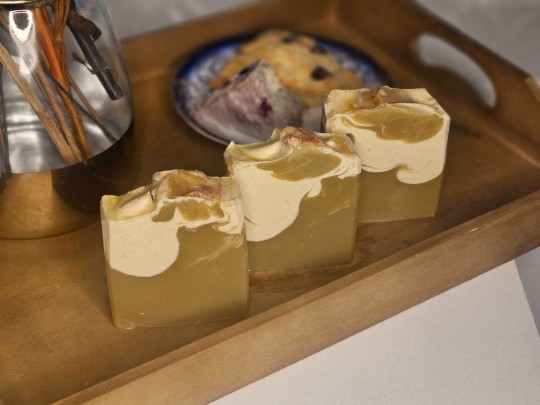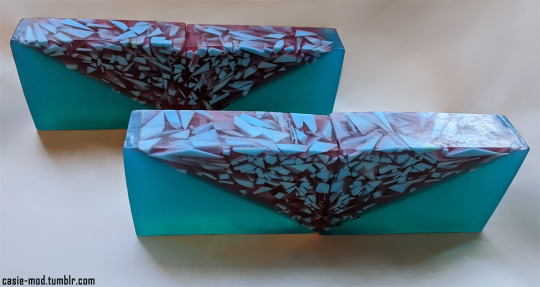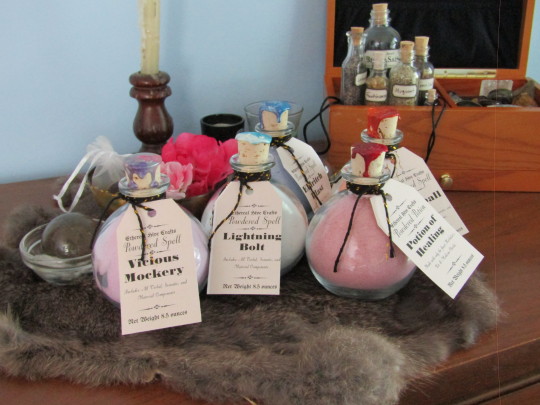#soapmakers
Text
Clutch - The Soapmakers
youtube
4 notes
·
View notes
Text






I made the Bonneville soaps, but I'm so scared they're not good enough quality for fundraising lol
Minty (black and green) smells like Elderflower and Apple Blossoms
Laura (orange and yellow) smells chamomile and has chamomile extract.
Ingrid (purple and blue) smells like lavender sage.
Bex (pink and dark pink) smells like strawberries/strawberry cheesecake.
Lark (green with white on top) is pine forest.
Briar (rose clay) is an upcoming character and smells like crackling fire.
#podcast#audiodrama#audiodramas#podcast audiodrama#the bonneville game#fiction podcast#soaps#soap#soapmaking#soapmakers#themed soaps#themed soap
0 notes
Text
Please, ConcernedApe, I want to adopt Jas!
#stardew valley shane#sdv shane#stardew shane#Just let me adopt Jas#soapfam#soap#cat and raven designs#soapmaking#cold process soap#cat and raven#cat and raven soap#artisan soap#handmade soap
61 notes
·
View notes
Text

just calling to catch up
(happy birthday to my own evil twin)
#haikyuu#haikyuu!!#miya atsumu#miya osamu#soapmaking osamu because this caters directly to my menace of a sibling#whose soap u should also check out… he is bastigod on tumblr and andraste_ on twitter
471 notes
·
View notes
Text
When marcille makes that soap for senshi and he’s like I wanna use it right now and she’s like it usually needs time to cure idk if it will work yet babygirls that is NOT the problem the PROBLEM is that when cold process soap is first made it is still so BASIC it will BURN you senshi you’re gonna burn your scalp.
34 notes
·
View notes
Text
Loser, Baby Artisan Soap!!

Fragrance: red wine, plum, raspberry
The Sticker of the Month is HuskerDust & the mini is Fat Nuggets

Next Month's Soap: Elemental Mythical Creatures

This soap & stickers are only available on our Patreon!!
#huskerdust#husk x angel dust#hazbin hotel#hellaverse#artisan soap#cold process soap#otaku#anime#geeky soap#artist#chibi art#small business#small artist#soap#soapmaking#soap maker
25 notes
·
View notes
Text
So, here's some fun stuff about fragrance oils you might not have known!
Certain scents contain compounds that will make your soap discolor over time. The most common and dramatic of these is vanillan, usually found in sweet scents because vanilla, and it will make your soap turn brown! The shade of brown will vary depending on how much vanillan is in the oil, what other discoloring compounds there are, etc, but the end result is brown. You can delay or remove it completely with a vanilla color stabilizer, but sometimes you can lean into it and know that it'll be the right brown you want once its done it's thing.
Most fragrance oil companies will have soap testing notes, because it's super important to know how the oil will react. Cold Process soap can get very complicated, because you have to watch for if the oil will curdle immediately, or do something funky to the color, or if it will behave and let you do some stunning and intricate patterns. These notes will include if the fragrance discolors and what color it will turn, ranging from tan to chocolate brown, to one note I saw suggesting 'light purple'.
Now, since cold process soap is very different from melt and pour/glycerin soap (which is what I use), these notes are often not relevant to me, and even the discoloration notes can be next to useless since they'll appear differently in a clear soap that doesn't have fun oils instead of reacting dramatically with, say, coconut oil.
Since it's still important to know if my soap is going to turn brown or stay how I color it, my solution has been to mix a few drops of fragrance with a tiny amount of soap in a little glass vial labelled with the name and the vanillan amount, and then leave it for a few weeks to see what happens. Sometimes this means nothing happens, sometimes this means I get a bright orange soap without any warning.
I've been toying with the idea of making these results into a database of some kind, so people can see how things discolor before they buy the oil, or even just because it's fun.
16 notes
·
View notes
Text







Baldur's Gate 3 Themed soaps! Can you tell which soap belongs with each companion?
Shadowheart -- purple + white swirls
Wyll -- red + grey + brown stripes
Gale -- blue + purple swirls
Astarion -- white + red swirls
Halsin -- brown + red swirls
Lae'zel -- green + black swirls
Karlach -- red + orange + yellow swirls
15 notes
·
View notes
Text
Guys I’m making soap do you think Tyler would appreciate the blueberry scent and glitter I’m adding
41 notes
·
View notes
Text



GOLDEN DEER (Claude) - Soap inspired by Fire Emblem 3 Houses
An earthenware cup of patchwork clay, warm to the touch. Crisp Almyran pine threaded with tangy lemon peel, cool anise, and a hint of vanilla musk, steeped for an hour then passed from hand to hand to the Barbarossa himself.
.
This is one of the few soaps I've had to switch scents for, as my original supplier discontinued the first one I used (which I still miss, weh.) The OG scent was kind of a fresh and unexpected sort of pine scent - warm with flecks of amber and citrus, emphasizing Claude's playful personality. This scent still has a base of pine (playing off one of Claude's favorite in-game teas hehe) but has colder, more complex notes of anise and vetiver - reflecting his more scheming, tactician's nature.
58 notes
·
View notes
Text

look at my soap
(the Shire in my LOTR themed soaps, pumpkin walnut biscotti sented, includes real pumpkin)
#soapposting#soap#cold process soap#soapmaking#soap making#every time i wander past my curing rack i have to huff it violently#kieran.txt
42 notes
·
View notes
Text
genuinely having to stop myself from going insane and buying more soaps. its dangerous to be around cheye when he's running out of his current soap supply ➡ can buy more soaps
#ive bought sum hair bars and a face scrub to go wit the body scrub i got recently...#now im looking for more body soaps...maybe a face soap... but i never know what face soap is Good#i feel like face soap riskier to buy from soapmakers idk i become nervous... bc its my Face...#talkys
47 notes
·
View notes
Text
Junimos are ADORABLE 😍
#junimos#stardew valley#stardew valley art#sdv#sdv fanart#soap#soapfam#cat and raven designs#soapmaking#cold process soap#cat and raven#cat and raven soap#soap making
24 notes
·
View notes
Text






Busy making soap while my motivation to draw has been in hibernation.
12 notes
·
View notes
Text
HEY YOU! DO YOU LIKE FANDOMS? DO YOU LIKE SMELLING GOOD? WHAT ABOUT SUPPORTING A TINY BUSINESS?


I'm the crafter behind Ethereal Hive Crafts! I make nerdy and fandom based soaps (like the Our Flag Means Death and Kiki's Delivery Service ones above!), bath bombs, bubble bath, and so SO much more!


Plus, on top of just the fandom goodness, all my things are made with eco-friendliness and biodegradable sources. That's right, even the glitter breaks down in time!
Oh, and if you're sensitive to scents? Not only can I make custom orders (or just custom soaps as a whole!) but I've gotten confirmation from customers that my soaps don't set off their asthma!

If you place an order, use "thankyou" at check out to get 10% off! Thank you!
#soapmaking#fandom#fandom soap#nerdy soap#bath bombs#the witcher#dnd#sailor moon#our flag is death#sea of thieves#critical role#good omens#the adventure zone#taz balance#kikis delivery service#discworld#h2g2
140 notes
·
View notes
Text
Experiments In Early Victorian Skincare: Shaving Soap, Part One


- And how does it feel, not being fetched for drops nor drawers?
- Miserable, sir. That is my job you are shaving away.
(AMC's The Terror, s01e07, "Horrible From Supper")
(Crossposted to Wordpress as usual)
We have some great period resources describing contemporary techniques for shaving and grooming, and they shed a little light on how landsmen, at least, were taking care of their facial hair. (If you're only interested in maritime personal care, this post gets a bit into the weeds on terrestrial soap manufacture, so be warned.) From The gentleman's companion to the toilet, or a treatise on shaving, credited to "a London hair-dresser" in 1844:
There are many soaps which are puffed off as "the best article manufactured for shaving" -- a "beautiful preparation for softening the beard," &c. &c.; but some of them are utterly worthless. All soaps are to be avoided which contain any considerable portion of alkalie; they make a light frothy lather that will not stand on the face, and they will much annoy you by those irritating pains, which are frequently felt after shaving with a bad razor. The soap which I have invariably found to be the best is Naples soap; it produces a beautifully mild creamy lather that will soften the beard, and will render shaving an agreeable operation, and is best calculated to allay those smarting sensations which an indifferent razor produces on a tender skin. There is a great deal of white honey used in the manufacture of Naples soap, and I need not say that there is nothing of a more mild and soothing nature.
Writing in the tail end of the previous century, Benjamin Kingsbury says exactly the opposite in his Treatise On Razors:
[...] Naples soap, so much admired by some persons, on account of the strength of it’s lather, is extremely defective. Of all the shaving soaps in present use, there is not one whose component parts are so irritating and injurious as the soap which is called by this name. It is the most caustic, and, of course, the most destructive to the skin, of all soaps and, in truth, to the production of a needless quantity of lather from a small portion of it, the soundness of the skin of the person using it is completely, and necessarily, sacrificed. [...] the best soap for the purpose of shaving which I have yet made, and which I always use, is the Olive-Soap, composed, in great part, of olive oil, and uniting the advantage of a durable lather with the power of softening and healing, rather than irritating, the skin of the person using it.
(What a drama queen.) Great, cool, but wtf is Naples soap? Thomas Webster's 1844 Encyclopaedia of Domestic Economy describes it as a "strong soft soap, scented; it comes to us in pots. In this era it's still an imported good, so recipes for imitation Naples soaps appear in contemporary books aimed at individual household consumers rather than commercial soapmakers. (Accordingly, these recipes generally seem to involve re-milling or otherwise rebatching existing soaps to add fragrance or combine the qualities of component commercially-available soaps.) Particularly among these imitation recipes, authentic Naples soap seems to be associated with the fragrances of rhodium, ambergris, and musk.

(from the 1844 Illustrated London News, Vol 4, Issue 95. Curious about the disreputable inferior-quality soaps touched on here!)
An 1835 chemical analysis suggests at least one variety used mutton fat as a base fat and potash as its saponifying agent, which is in line with what our London hair-dresser says about lye soaps' insufficient lather. (The existence of this analysis really amuses me -- it seems like people in the US and UK were curious about what really went into this particular import.)
From William Brande's 1848 Manual of Chemistry:
The soaps of potassa are distinguished from those of soda by remaining soft; common soft soap is frequently made with fish oil. Naples soap is a perfumed potassa soap made with lard.
Interestingly, I'm not seeing anyone else mention the "white honey" that our London hair-dresser attributes to the ingredients list here, but honey is a pretty common additive in natural soapmaking, so I'm not about to write it off entirely.
Soft Naples soap isn't the only soap used for shaving in this era -- any number of toilet soaps seem to have been in use, and at least some of these used regular soda lye. Rather than jump right in with potash lye, I wanted to make one of these first.
Shaving Soaps: Take One
Modern home soapmakers have a huge range of tools available to them that even commercial soap manufacturers of the 1840s did not -- digital scales, laser thermometers, Crockpots, electric stoves -- so in this case rather than reconstructing period methods I'm going to try and translate those techniques to a modern toolset.
First, I made a batch of tallow shaving soaps with soda lye/sodium hydroxide -- apart from the use of tallow, this was a thoroughly modern recipe, incorporating a range of vegetable oils to fine-tune the consistency and conditioning powers of the resulting bar. I used equal parts coconut oil and beef tallow, supplemented with sunflower oil, castor oil, olive oil pomace, and unrefined cocoa butter; the only other notable ingredient was powdered clay, both for cleansing powers and increased slip. (You could use white kaolin clay or off-white bentonite clay for a lighter-colored bar; I worked with French green clay because that's what I have on hand most of the time, so my bars ended up a pretty attractive sage-green color. Some people claim that the inclusion of clay dulls their razor blades, but I don’t know that I’m using any given razor blade for long enough for that to matter, and I didn't find it to be a problem when using.)
[Here's where I'd put a photo of these bars in the mold... IF I HAD ONE... so you'll have to settle for this store link.]
What's this bar like to shave with? I'm going to be honest: it's really nice, to the point where I'm considering using it as basically a leave-on mask. I shave with a safety razor and occasionally a wet-dry electric razor, but I don't use a brush to lather up, so I just used my hands with this bar on damp skin; there wasn't a really fluffy voluminous lather, but it made for a really sleek and easy-to-navigate shaving surface and a pretty damn close shave without much friction. The clay component adds a little satisfying tooth to the shaving experience while leaving my face feeling really clean and non-greasy after.
So clearly I like it ,and I've gotten nice feedback from others. But it's not a Naples soap. It's not made with potash lye. What might a more authentic Naples shaving soap look like? If there are other modern takes on a soap like this, I'm having a hell of a time finding them under the search engine optimized-shadow of the Florida-based Naples Soap Company.
What makes a Naples soap?
So to review we're looking for: soft soap, scented soap, animal fat base, and critically, that potash lye mentioned earlier. Potassium hydroxide is an entirely new beast to me -- in soapmaking, it can be used alone or in tandem with sodium hydroxide to create a softer soap, up to and including straight-up liquid soaps. I felt like a horse's ass putting together that, yeah, "potash" really does just come from "pot ash", and "potassium" is just halfassed Latin for the same. If your mental image of old-timey soap making is Almanzo Wilder in the Little House books you're on the right track -- making soft soap was an annual thing for many homesteaders, and the potash was sourced from the previous year's collection of wood ashes.The resulting jelly-like soap got stored in a barrel and doled out as needed. Common salt or table salt could be added to the soaping process for hardness, but in a Colonial American or homesteading context I can't imagine that was always economically feasible.
The barrel approach is in line with what I'm seeing modern soapmakers describe with soft olive oil-based Castile soaps -- you can dilute your soap goo right out of the gate to the consistency of a Dr. Bronner's-type liquid soap (though Dr. Bronner's 18-in-1 soaps are made with coconut and palm kernel oil to supplement their olive oil content these days) but more water means more potential for spoilage, so keeping around a jar of goo and diluting it as needed is a more shelf-stable option.
Period soap recipes are made at scale -- measuring ingredients in pounds, not ounces, and in particular testing the strength of lye solutions by measuring their density against that of a fresh hen's egg. (This method apparently goes back to the sixteenth century and can be used as a rough-and-ready test for a number of different solutions -- for more, check out this post by Homestead Laboratory or this historical overview of the egg test's use in brewing and mead-making from A Booke Of Secretes.
I'm not making my own lye, whether soda or potash, and in fact I prefer to fuck around with lye as little as possible. (Over the course of this project I had the revelation that this is 100% because of the chemical burn scene in the movie Fight Club.) But it behooves me to get familiar with potash lye soaping.

(from The Critic, Vol. XIII, No. 322, 1854)
Shaving Soaps: Preparing For Take Two
So what am I making for my second round here? Instead of a soap cut from a bar or popped out of a mold, I want to make the equivalent of a soap in a pot -- something soft-textured that can be lathered in its container but that's also portable. The descriptions of shaving soap as "soft" don't do me a lot of good -- *how* soft are we talking? Are we talking soft like jelly, like the OG Colonial-style soft soap made with exclusively potash, or just not rock-hard? It's possible to strike a balance between rock-hard and goo-soft by combining both types of lye (what the SoapMaker tool calls a "cream" soap) but I'll need to dig into industrial soap writing from our era to get a sense of whether that was a contemporary historical practice on the initial processing level rather than by rebatching together lye soap and potash soap later.
I’m going to hit up tools like SoapCalc and Soapee's lye calculator for guidance even as I experiment, since soap I'll be sharing with friends isn't a place I want to fuck around with caustic material. Potash lye by itself apparently makes a great soft soap with a consistency I've seen compared to Vaseline (or more bluntly, lumpy goo) but in modern soapmaking terms it's a hot process (HP) soap. Instead of undergoing the saponification process over time as it rests in the mold, hot process soap saponifies while being steadily heated in a vessel like a slow cooker; it still needs to cure afterward, but there's no need for zap-testing and in theory it's usable right out of the gate. HP soaping is new to me as well, and it means I had to get my hands on an estate sale Crock-Pot.
Which fats do I want to use? 100% beef tallow will make a stable and extremely hard soap (even when made with potash) but not with a lot of conditioning or cleansing power; so would 100% palm oil, for that matter. (I did get my hands on some sustainably-sourced palm oil for soaping, but I'm planning on holding off on using it for now.) Olive oil-based soft soaps are gentle and conditioning but don't generate a lot of lather. All these distinct properties of various fats are pretty much how soaps made with oil blends came to be, and those multi-oil soaps are attested elsewhere in the Early Victorian era; one recipe for imitation/homemade Naples soap
I want to put together a scent blend that approximates or is inspired by the notes listed above: rhodium, ambergris, musk. Only problem: What the fuck is rhodium? Later in the Victorian era, George William Septimus Piesse describes it as follows in his Art Of Perfumery:
When rose-wood, the lignum of the Convolvulus scoparius is distilled, a sweet-smelling oil is procured, resembling in some slight degree the fragrance of the rose, and hence its name. At one time -- that is, prior to the cultivation of the rose-leaf geranium -- the distillates from rose-wood and from the root of the Genista canariensis (Canary rose-wood) were principally drawn for the adulteration of real otto of roses; but as the geranium oil answers so much better, the oil of rhodium has fallen into disuse, hence its comparative scarcity in the market at the present day, though our grandfathers knew it well. One cwt. of wood yields about three ounces of oil.
So yeah, for an adult man in 1879, rhodium as a rose-adjacent fragrancing element must have seemed pretty retro. Perfect for this guy's hypothetical grandfather, though. The equivalent listing for rose-leaf geranium describes it similarly as an adulterant or potential alternative for rose otto. The bad news is, rose otto is still wildly expensive, and rosewood itself is now under substantial environmental protection restrictions... as is ambergris. I've got two options in my back pocket here -- fragrancing soap with rose geranium, maybe paired with botanical musk or a synthetic ambergris, or finding myself a nice modern fragrance oil. I... would rather do the former than the latter, but eh, we'll cross that bridge when we get to it.
What qualities am I looking for in the soap itself? What makes a good shaving soap? People have different preferences when it comes to soap lather consistency, especially if you're used to an aerosolized shaving cream. We're looking to strike a balance; lather that’s mild and creamy but not slimy, conditioning and lubricating but not leaving a residue behind. Given my druthers I'd like to make a couple test batches, looking to fine-tune these various qualities, but just how that's going to work out for me will remain to be seen.
So, yeah, soap. Shaving soap. What about the actual process of shaving with it? What's the razor situation? What about the daily ablutions of officers and average seamen? What about muttonchop maintenance? What about the wild world of Early Victorian shaving literature? More on that soon as I document my cold boy hot process soaping. Tune in next time for: goo.
19 notes
·
View notes